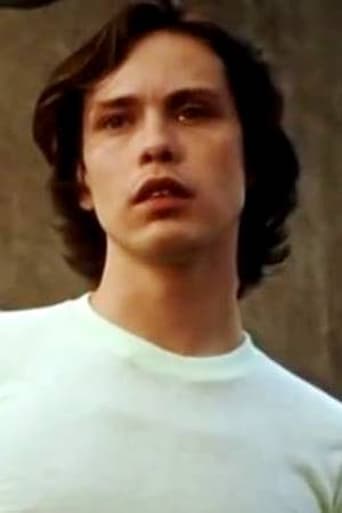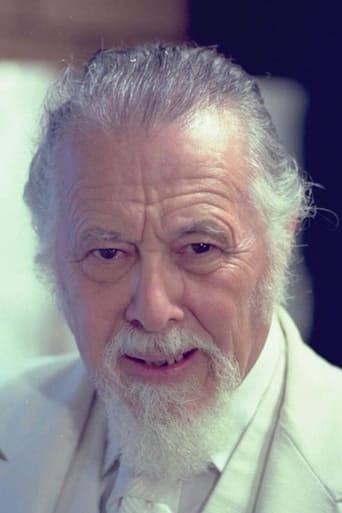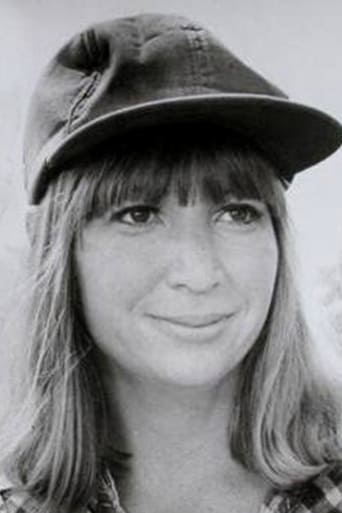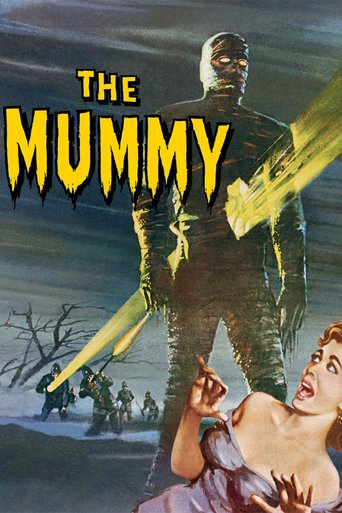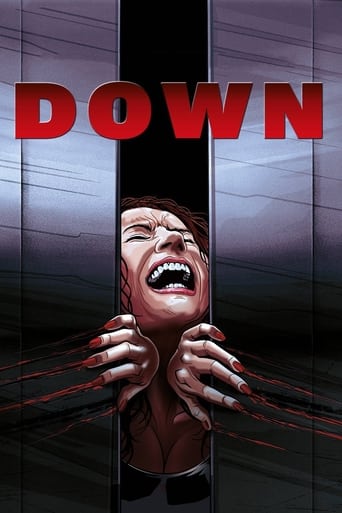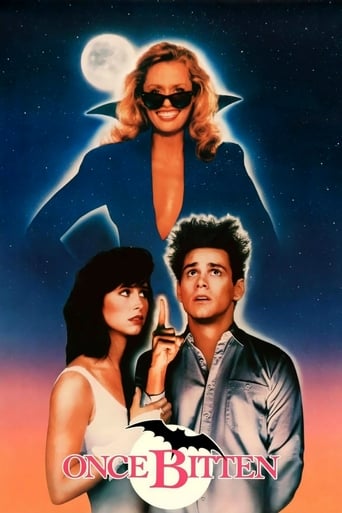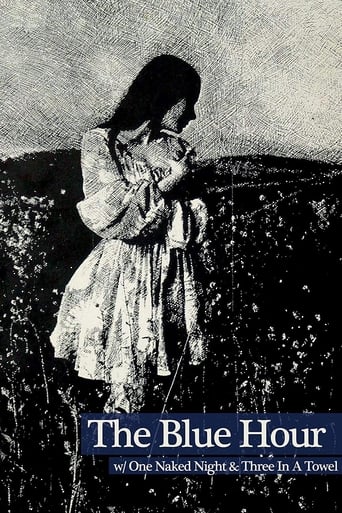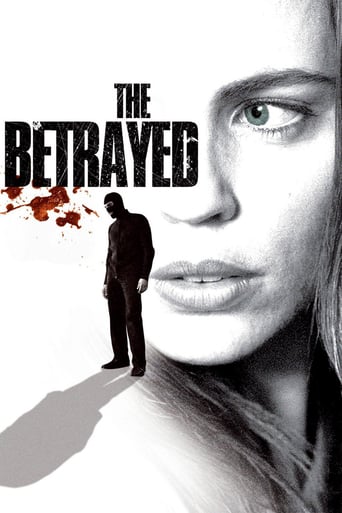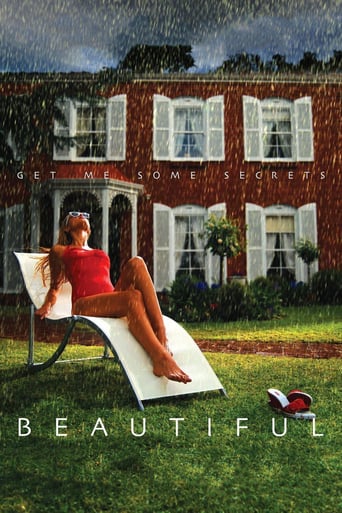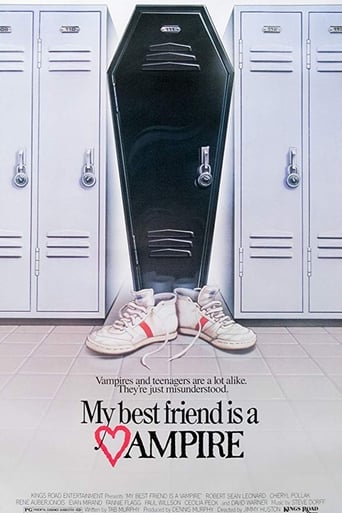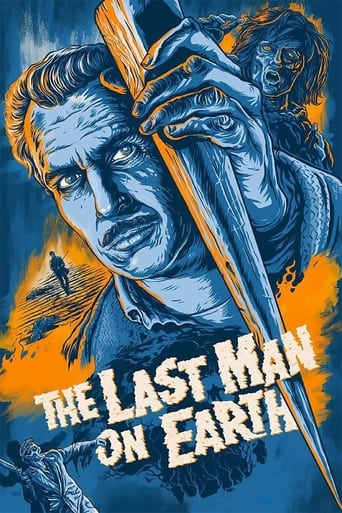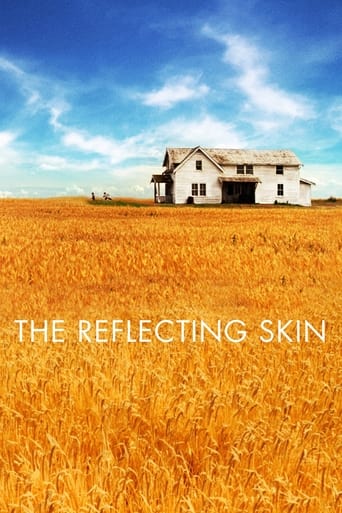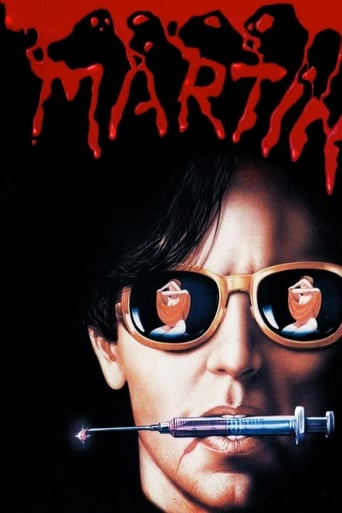
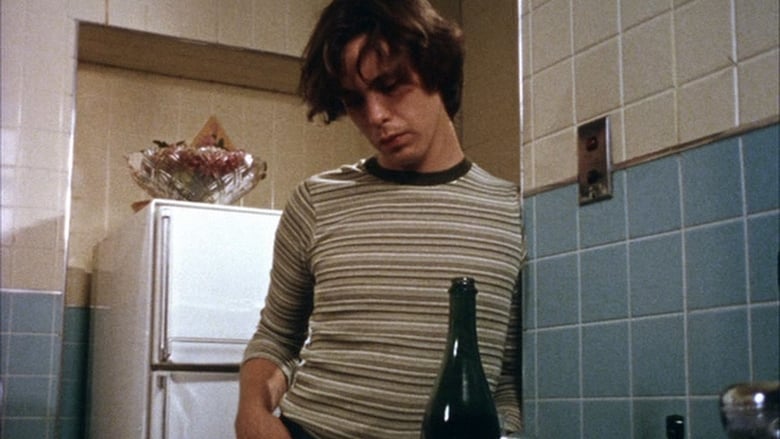
Martin (1978)
Martin, who believes himself to be a vampire, goes to live with his elderly and hostile cousin in a small Pennsylvania town where he tries to redeem his blood-craving urges.
Watch Trailer
Cast


Similar titles
Reviews
Deciding on Braddock — one of the hardest hit mill towns — and utilizing family and friends, Romero started to film what he would later call his favorite film.In the film's first script, Martin is an older man who is definitely a vampire, struggling to live (unlike?) in the modern world. But after seeing John Amplas in a Pittsburgh Playhouse production of Philemon, Romero rewrote the film to make Martin younger and more innocent.Martin's family has all died in Indianapolis, so he's on his way to Pittsburgh — but not before shooting a woman up full of drugs and drinking her blood. He's met at the train station by his uncle, Tateh Cuda, and taken to his new home: Braddock, PA. Even today, Braddock is one of the most run down sections of Pittsburgh — the decay evident in the movie got a lot worse before John Fetterman was elected and numerous civic campaigns have brought new business in. That said — it's still a great setting for a horror film.Cuda and his niece Christine share a home and have allowed Martin to stay. The old man gives Martin several rules, including one that if ever kills anyone in Braddock, he'll stake him through the heart. He keeps crucifixes and garlic all over the house, continually telling Martin that first, he'll save his soul, and then, he kills him. Martin yells at Cuda, showing him that he can touch the crucifixes and eat the garlic and bitterly exclaims, "There's no real magic ever."This is in direct contrast to Martin's fantasies, shot in black and white (there's supposedly a 2 hour and 45 minute cut of this film that's only in black and white) like a romantic vampire movie, where women willingly give up their throats to him. The truth — he barely defeats the women in battle, needs drugs to sedate them and with no fangs, he must use a razor blade to kill them.Despite Cuda's continual threat's of death, he hires Martin to work in his butcher shop as a delivery man. This allows him to meet several woman, including Mrs. Santini, who tries to seduce him. Unlike his dreams of control over these women, he can't even control his own feelings and runs away.Pittsburgh has always been a talk radio town — local powerhouse KDKA boasts a 50,000 watt antenna that can be heard throughout most of the continental US in the evening — and Martin takes advantage of this, calling a local DJ (Michael Gornick, director of Creepshow 2) to try and figure out life. He becomes known as "The Count" and is one more lonely voice seeking comfort until the sun comes up — again, in marked contrast to the way vampires traditionally fear daytime. The DJ segments hit close to home — I was a long-time listener (1989-2005) of Bob Logue's Undercover Club and Pittsburgh has a long history — as stated above — of radio shows like Party Line. We're slow to give up on technology, so AM radio still remains strong here.Martin tries to keep his thirst under control, but finally sneaks out to the big city — Pittsburgh is very much a bridge and tunnel town where folks stay within one of the ninety small neighborhoods that make up the overall town — and attacks a woman he'd seen at Cuda's market. But she isn't alone — she already has an extramarital lover over — and Martin barely overcomes them both before he drugs and rapes the woman.Read more at http://bit.ly/2l3GYwj
Along with Travis Bickle, Martin (John Amplas) is surely one of the great on-screen loners. He is isolated from the society he inhabits because he is an eighty-five-year-old vampire. 'Martin' is set in Braddock, Pennsylvania and there is a wonderful sense of a town stuck in time while the rest of the world has moved on. Perhaps Braddock was once a booming steel town which has fallen on hard times.There is definitely something intensely disturbing in the way Martin attacks and drugs his victims before slicing their veins open with a razor blade and feeding upon them. The film contains some shocking violence so be warned; it is not for all tastes. 'Martin' has a wonderful sense of timelessness which has a lot to do with the black-and-white flashbacks and the dreamy, surreal quality of working-class Braddock. Instead of feeling that he is eighty-five, the flashbacks make us feel that Martin has lived since time immemorial, walking down his lonely road through the ages.One of the most interesting things about 'Martin' is Martin's relationship with Mrs. Santini (Elyane Nadeau). She is a desperately sad character who befriends Martin and penetrates his shyness. Another bond Martin forms is with the host of an all-night call-in radio talk show. Martin calls himself 'the Count' and discusses with the host quite matter-of-factly his behaviour as a modern vampire.Lincoln Maazel is excellent as the tyrannical, patriarchal Cuda who rules his household with an iron fist and who considers Martin the albatross around his neck, the unspoken shame and bane of his family. Christine Forrest - who would go on to marry the film's director, George A. Romero - offers solid support as Christina, Cuda's daughter. She befriends Martin warmly, ignoring his idiosyncrasies. The film's special effects makeup artist, Tom Savini, plays the role of Arthur who is Christina's unpleasant boyfriend.The Umbrella DVD edition has lots of juicy extras for you to get your teeth into but, much to my disappointment, there are no interviews with John Amplas or Elyane Nadeau (RIP). 'Martin' is one of my all-time favourite films.MAJOR SPOILER WARNING: There is crucial dialogue at the conclusion of the end credits.
When I said in my review of his legendary Night of the Living Dead, that George Romero is a horror director with a very inconsistent record, this film sticks out most in my mind as proof of that struggle. Between trying the hardest to be a character study and having to fill out the genre requirements to be sold as a horror film. For his sake, I'm thankful that much of his work feels like it's straining to be horror. Because were it not to add those elements, I wouldn't be interested in seeing his films at all. Without the threat of zombie invasion, 1985's Day of the Dead would be a painfully tedious and irritatingly over the top war flick about people yelling at each other. 1978's Dawn of the Dead would be an action film about people trying to survive the breakdown of society from... what would most likely be anarchy caused by widespread riots and outbreaks of street crime (the sort you'd see in something like 1979's The Warriors or 1978's Saturday Night Fever), were you to take out the zombies. 1973's The Crazies would lack the tragedy to make the boring military effort to contain the outbreak of disease worth watching.And 1976's Martin would be a lame art film about a lanky, skinny dork walking around the neighborhoods of Pittsburgh, watching the people interacting and realizing his upbringing was just not normal. Which is what most of Martin is anyway, save for a half dozen scenes of Martin stalking women, drugging them, then raping them and cutting their wrists so he can suck their "blood," which looks so much like melted-crayons, you'll wonder why the strangely un-vampiric Martin likes to drink it so much. All while the fairly mopey boy narrates almost every shot he's in. And he's in almost every shot. I was once told that narration is the last resort of a screenwriter, a product of desperation. In Martin, rather than Romero using the narrations as a tool of creepy foreshadowing, it's more to provide internal reflections over why Martin is doing what he does. Which, not to beat on a dead horse but, is really quite boring. As is the character of Martin. Who is the entire film.Is Martin a vampire or is it in his own head? Good question. My answer? I don't care. What I want most from a horror film, regardless of how ambitious it is or not, is to be entertained. All said and done, a horror film being scary is a great thing. But it's a luxury. Something I just can't expect from every horror film I see. So, I try to go with the flow. So, how does Martin flow? Quite well, all things considered. Romero does have a style to most of his films. And even though I find The Crazies to a better final film (partly because of the fact that it looks haphazard stylistically, and documentary-like), Martin is a better film in terms of style or atmosphere. Romero is the horror King of library music tracks, which has always bothered me. But, maybe I should lighten up on that. As a matter of fact, I'll never know or never care to know where the original tracks came from. So, the usage of this music by Romero's films is like sampling the flavor of music at the time. One of the few things I truly like about Martin is that I remember the music. The hallucinogenic, reverberating, trapped-in-a-glass-jar quality to most of the pieces.The other thing Martin really has going for it is Martin's amusing reactions to 1970's America. If he really was an 80-something year old vampire with almost no exposure to American culture outside the occasional children's novelty toy or magic tricks, watching him browse through stores and his amazing reaction to the sight of a suicide victim, is downright priceless. Romero's foremost focus in Martin is irony. And the film is chock full of incidences of that. Usually, it's nothing impressive. But one scene really blew me away. Martin breaks into a thrift shop at night, which trips off a burglar alarm. The cops are quick to arrive and Martin has to cut it close to evade capture. This scene is the pinnacle of Romero's brand of suspense. As Martin clings to the walls and ducks and dives around objects to hide himself from the cops' eye- I'm on the edge of my seat. Martin leaps out the door and flies through the streets, desperately looking for somewhere to hide out. As he enters the first dark place he sees, he finds himself in the hide-out of some kind of black gang. Because of Martin, the police have inadvertently caught more criminals. But brilliantly, the two sides have a shoot-out and everyone dies... everyone except Martin.Now, that's a stroke of genius. Irony is what makes it happen. But what makes it so enjoyable is that it is completely unpredictable. Though there are several other scenes in Martn that are unpredictable, none are as filling as this one. Perhaps the film's greatest attribute is that it serves as something of a response to the pressure from Christians or Catholics to conform to what is a normal manner of behavior, etc. When Martin is seen as having "unnatural" impulses, his religious Uncle (was he his uncle? I don't remember) brands him as evil and Satanic, etc. This is some small comfort for the viewers who have experienced psychotic religious people before in their lives, and living in America- it's almost impossible to avoid all of them. But, consider this: I'm getting schooled in religious ethics by a film whose main character is raping and killing women. Which is my second biggest complaint about the movie (the first is how boring Martin the character is). I guess I understand why he wants to rape the women. But, why do I want to watch him doing it?
Few horror movies have dared to be so different. This may be one of Romero's finest moments. The cinematography is brilliant and the directing is genius. This film shows Romero's creative ingenuity, unspoiled by studio interference. "Martin" is raw. It's realism is intertwined with haunting scenes of abstract flashbacks. The musical accompaniment is beautifully alluring and emotional binding. Every shot has meaning, nothing is wasted or taken for granted. This film gives us a Romero that has been lost in our modern culture based on selfishness. "Martin" should conjure strong feelings for those of us that remember the 70s and be a learning experience for those whom were not yet born. This film has certainly been overlooked by mainstream movie goers. "Martin" is about a young man with a need for fresh human blood, similar to that of a vampire. But Martin isn't a vampire: He has no fangs, he walks in the sunlight, garlic has no effect, and has no fear of crosses. Yet, his need for blood compels him to kill. "Martin" is a one of a kind vampire film, if it can be called a vampire film at all. Doing so conjures up images of Hollywood's slick portrayal of vampires, which couldn't be further from Romero's work in this picture. "Martin" is far from Hollywood's idealistic vampire showing. Romero defies contemporary vampire conventions by steeping Martin's vampirism in realism and the harsh light of day in a dying city."Martin" certainly isn't for everyone. As an avid Romero film patron, this film means much more to me than a Romero novice will most likely take away from this picture. Romero does a cameo appearance as a priest, which is a must see for Romero admirers. I can see how this film might be difficult for younger film goers or for film goers that don't have a true understanding of cinematic production and creation. The cinematography is original and invigorating as it uses a dying urban backdrop to create an emotional plethora of depression, death, and hopelessness. At the same time this urban backdrop offers reconciliation and hope to even the lowest ranks of American society.This film is simply beautiful. It is more art than film. And for those of us that can't see the special nature of this production, I recommend that you stick to Michael Bay movies. Is "Martin" a perfect film? Far from it. BUT! It's filming techniques are an excellent lesson in the art of camera placement, editing, lighting, and direction. This is a film that should be acknowledged more for what it does do than for what it does not do. And what it does do is offer us a rare glimpse into intelligent film-making at a time and place that is now lost. "Martin" is an inspiration and deserves to be at least respected by informed film-goers.


